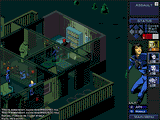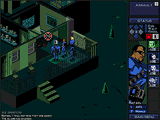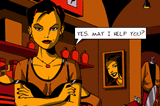 The premise of Shadow Watch is intriguing; eye-catching
turn-based action that features a narrative driven by a unique interrogation interface. And of course the first thing that anyone notices
about this game is the stylish graphic novel visuals. The comic book style is a bit risky,
but pays terrific dividends in atmosphere. The premise of Shadow Watch is intriguing; eye-catching
turn-based action that features a narrative driven by a unique interrogation interface. And of course the first thing that anyone notices
about this game is the stylish graphic novel visuals. The comic book style is a bit risky,
but pays terrific dividends in atmosphere.
 Shadow
Watch's campaign takes place in the three cities of Rio de Janeiro, Baikonur, and Hong
Kong and involves uncovering a plot to prevent the construction of an international space
station. There are three possible subplots for each city, and although each starts with
the same event, the game will offer up new contacts and open up new paths through the
missions. Each subplot has 25-30 missions but you'll move on to a new city after
completing five missions. Shadow Watch keeps track of the paths taken in each campaign
played and will make sure that no plot lines or scenarios are repeated until all the
permutations have been exhausted. The replay value is further increased by the fact that
the three differing factions in the cities will be shuffled around. One will be friendly, one will be neutral and the
last will be openly hostile. Because this is changed throughout the campaign, you'll never
really know whom to trust. Shadow
Watch's campaign takes place in the three cities of Rio de Janeiro, Baikonur, and Hong
Kong and involves uncovering a plot to prevent the construction of an international space
station. There are three possible subplots for each city, and although each starts with
the same event, the game will offer up new contacts and open up new paths through the
missions. Each subplot has 25-30 missions but you'll move on to a new city after
completing five missions. Shadow Watch keeps track of the paths taken in each campaign
played and will make sure that no plot lines or scenarios are repeated until all the
permutations have been exhausted. The replay value is further increased by the fact that
the three differing factions in the cities will be shuffled around. One will be friendly, one will be neutral and the
last will be openly hostile. Because this is changed throughout the campaign, you'll never
really know whom to trust.
At the beginning of each scenario, you'll have the chance to
interview at least one suspect in the city. This interview leads to one of at least six
separate missions. Completion of the mission leads to one or two additional branches of
inquiry. These lead to more missions that in turn lead to more investigations and so on.
Once you've run five missions, you move on to the next city and ultimately to the final
game mission.
 The
investigation portions of the game are nicely done. You meet contacts, get all sorts of
info, and plan the next phase of your operation. Faction and character dossiers are
provided to give you the proper context for your conversations, but keep in mind that the
roles of the characters and factions will change from campaign to campaign. After a brief
introduction by the contact, there is the choice of three responses. This prompts another
dialogue for which you will have two new responses which results in six separate endings
to any investigation. How you deal with your contacts will determine not only the next
available missions but also the shape of the plot as whole. The
investigation portions of the game are nicely done. You meet contacts, get all sorts of
info, and plan the next phase of your operation. Faction and character dossiers are
provided to give you the proper context for your conversations, but keep in mind that the
roles of the characters and factions will change from campaign to campaign. After a brief
introduction by the contact, there is the choice of three responses. This prompts another
dialogue for which you will have two new responses which results in six separate endings
to any investigation. How you deal with your contacts will determine not only the next
available missions but also the shape of the plot as whole.
 There are
6 different locations in each city for the missions, from a cathedral to an electronics
factory to a town hall. There are plenty of different experiences on the same maps as the
eight separate mission types keep things from getting monotonous. The compact, one-level
maps are impressive; each map presents differing tactical options that demand a variety of
approaches. More often than not you will be setting up situations where enemies
wander into your firing arcs rather than simply rushing into rooms and in a killing
frenzy. Though you can march in with guns
blazing on the assault missions, you'll want to keep things more subdued during the theft
and surveillance missions. Occasionally you'll also have to hold off enemy assaults or
kidnap specific individuals. There are
6 different locations in each city for the missions, from a cathedral to an electronics
factory to a town hall. There are plenty of different experiences on the same maps as the
eight separate mission types keep things from getting monotonous. The compact, one-level
maps are impressive; each map presents differing tactical options that demand a variety of
approaches. More often than not you will be setting up situations where enemies
wander into your firing arcs rather than simply rushing into rooms and in a killing
frenzy. Though you can march in with guns
blazing on the assault missions, you'll want to keep things more subdued during the theft
and surveillance missions. Occasionally you'll also have to hold off enemy assaults or
kidnap specific individuals.
One of the small shortcomings of the game is that you'll lose the
entire game if even one of your characters is killed or if you fail to meet the mission
objectives. And the enemy AI is good enough to make this a real possibility.
 Missions
are a lot like a simpler version of X-Com and the simplicity works; the whole game runs
with a few intuitive hotkeys. The combat system is designed so well that you'll be playing
the game without having to make reference to the manual after the first few minutes. Each
character has a certain number of action points and a certain number of morale points. The
character with the highest action point total acts first and can allocate points by
moving, firing, opening doors and a whole host of other activities. For every traumatic
event that occurs, nearby players have their action point total raised temporarily. If the
action points exceed the morale points, the character panics and can no longer be
controlled until their action points fall below their morale points. Missions
are a lot like a simpler version of X-Com and the simplicity works; the whole game runs
with a few intuitive hotkeys. The combat system is designed so well that you'll be playing
the game without having to make reference to the manual after the first few minutes. Each
character has a certain number of action points and a certain number of morale points. The
character with the highest action point total acts first and can allocate points by
moving, firing, opening doors and a whole host of other activities. For every traumatic
event that occurs, nearby players have their action point total raised temporarily. If the
action points exceed the morale points, the character panics and can no longer be
controlled until their action points fall below their morale points.
Each character has unique abilities and is visually distinct as
well; individual identification is quite simple. Archer is the leader and his ability to
influence morale and initiative are extremely important. Lily, the martial arts expert, is
good at killing people silently. Bear is the point man. He can absorb a ton of damage
before he goes down and his shotgun makes short work of anything in his way. Maya the
sniper delivers devastating shots but is limited in movement. Gennady is the sensor man,
and although he has no weapon, his ability to detect enemy presence through walls and
closed doors makes him a valuable member of the team. Who you pick to take on the missions
is critical; Rafael and Bear tend to kill lots of people at full volume so they're best
for straight assault or defense missions. On
the other hand, Lily and Gennady are better used when you're trying to avoid detection on
theft or surveillance missions.
 As your
characters gain experience, you'll be able to train them in new skills. Archer's skill set
deals primarily with morale bonuses. His Go-Code skill allows all of your characters to
get an extra turn in which the enemies can only dodge and cover. Maya gains the medic
skill, which will save your hide in some of the more unforgiving missions. Rafael gains
access to different types of grenades and can even learn to blow up doors so effectively
that anyone standing on the other side is taken out as well. If trained, Gennady can locate objectives and
guards at the very beginning of the mission and can also learn to pick locks. The skill
trees offer nine unique skills for each of the characters and although a few are
ineffective, most are extremely useful. As your
characters gain experience, you'll be able to train them in new skills. Archer's skill set
deals primarily with morale bonuses. His Go-Code skill allows all of your characters to
get an extra turn in which the enemies can only dodge and cover. Maya gains the medic
skill, which will save your hide in some of the more unforgiving missions. Rafael gains
access to different types of grenades and can even learn to blow up doors so effectively
that anyone standing on the other side is taken out as well. If trained, Gennady can locate objectives and
guards at the very beginning of the mission and can also learn to pick locks. The skill
trees offer nine unique skills for each of the characters and although a few are
ineffective, most are extremely useful.
There are those that will say turn-based gameplay and comic book
graphics will never compete with real-time, 3D games.
If you agree with this position then Shadow Watch isn’t for you. If, on the other hand, you’re looking for a
thoughtful, stylish, and elegant gaming experience, give this entertaining tactical-combat
game a try. Shadow Watch is a very pleasant
surprise that offers ample enjoyment and replay value.
--Al Wildey |